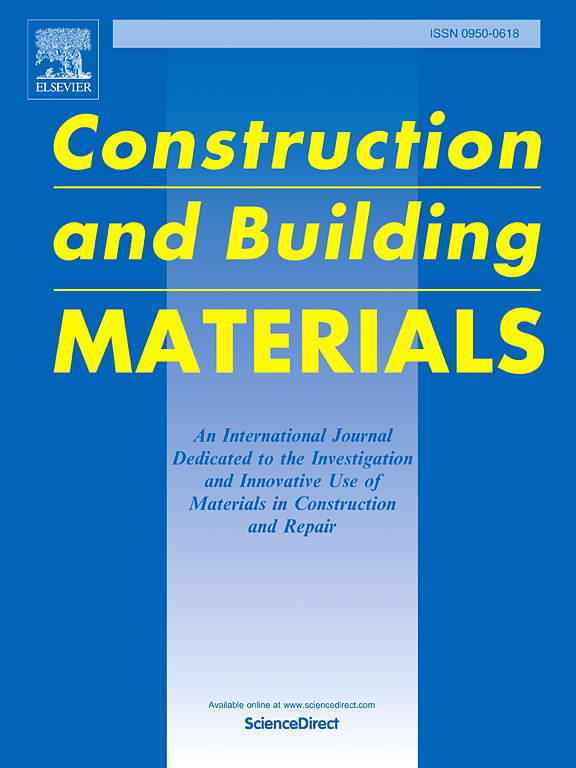Passivation behavior of steel in alkali-activated materials and corrosion behavior under carbonation conditions
IF 7.4
1区 工程技术
Q1 CONSTRUCTION & BUILDING TECHNOLOGY
引用次数: 0
Abstract
This study investigates the passivation behavior of steel in simulated pore solutions at various hydration stages (early, middle, and late) in alkali-activated materials (AAMs) and the corrosion behavior under simulated carbonation conditions. Portland cement was used as the control group. The research initially focused on studying the passivation behavior of the steel. The results revealed that in the waterglass-activated solution (WGS), a higher Si/Al ratio (>1.5) promoted the formation of an aluminate/silicate adsorption layer on the steel surface, which effectively reduced the negative impact of S2- on the passive film. In contrast, the NaOH-activated solution (NHS) with a Si/Al ratio lower than 0.5 led to the formation of a loose passive film containing FeS. Both the adsorption layer in WGS and the FeS-containing passive film in NHS showed thicknesses exceeding 30 nm. In the Portland cement solution (PCS), a double-layer passive film with a thickness of less than 10 nm was formed. When subjected to simulated carbonation conditions with reduced pH, the critical pH values for corrosion initiation of the passive film in the WGS and PCS groups were similar, around 8.5. However, the NHS group exhibited a significantly higher critical pH of 12.5. This discrepancy arises because the adsorption layer in WGS and the dense passive film in PCS provided better corrosion resistance, whereas the loose FeS-containing passive film in NHS offered weaker protection.
钢在碱活化材料中的钝化行为和碳化条件下的腐蚀行为
本研究研究了钢在碱活化材料(AAMs)中不同水化阶段(早期、中期和晚期)的模拟孔隙溶液中的钝化行为,以及模拟碳化条件下的腐蚀行为。以波特兰水泥为对照组。研究最初集中在研究钢的钝化行为。结果表明,在水玻璃活化溶液(WGS)中,较高的Si/Al比值(>1.5)促进了钢表面铝酸盐/硅酸盐吸附层的形成,有效降低了S2-对钝化膜的负面影响。相比之下,Si/Al比低于0.5的naoh活化溶液(NHS)形成了一个松散的含FeS的钝化膜。WGS中的吸附层和NHS中含fes的钝化膜的厚度均超过30 nm。在波特兰水泥溶液(PCS)中,形成了厚度小于10 nm的双层钝化膜。在降低pH值的模拟碳化条件下,WGS组和PCS组钝化膜腐蚀起始的临界pH值相似,都在8.5左右。然而,NHS组的临界pH值明显高于12.5。这是因为WGS中的吸附层和PCS中的致密钝化膜具有更好的耐腐蚀性,而NHS中松散的含fes的钝化膜具有较弱的保护作用。
本文章由计算机程序翻译,如有差异,请以英文原文为准。
求助全文
约1分钟内获得全文
求助全文
来源期刊

Construction and Building Materials
工程技术-材料科学:综合
CiteScore
13.80
自引率
21.60%
发文量
3632
审稿时长
82 days
期刊介绍:
Construction and Building Materials offers an international platform for sharing innovative and original research and development in the realm of construction and building materials, along with their practical applications in new projects and repair practices. The journal publishes a diverse array of pioneering research and application papers, detailing laboratory investigations and, to a limited extent, numerical analyses or reports on full-scale projects. Multi-part papers are discouraged.
Additionally, Construction and Building Materials features comprehensive case studies and insightful review articles that contribute to new insights in the field. Our focus is on papers related to construction materials, excluding those on structural engineering, geotechnics, and unbound highway layers. Covered materials and technologies encompass cement, concrete reinforcement, bricks and mortars, additives, corrosion technology, ceramics, timber, steel, polymers, glass fibers, recycled materials, bamboo, rammed earth, non-conventional building materials, bituminous materials, and applications in railway materials.
 求助内容:
求助内容: 应助结果提醒方式:
应助结果提醒方式:


